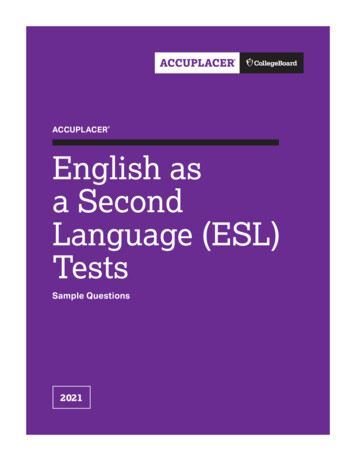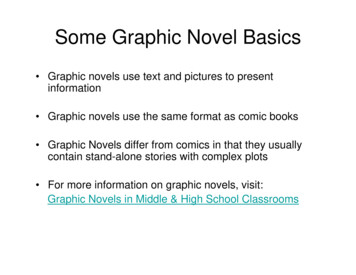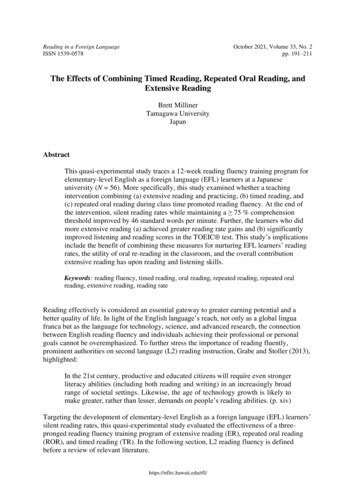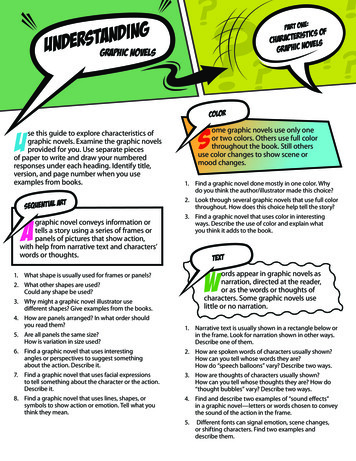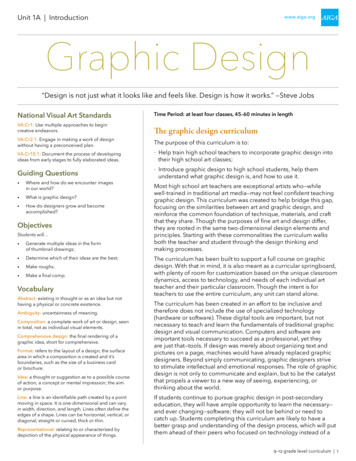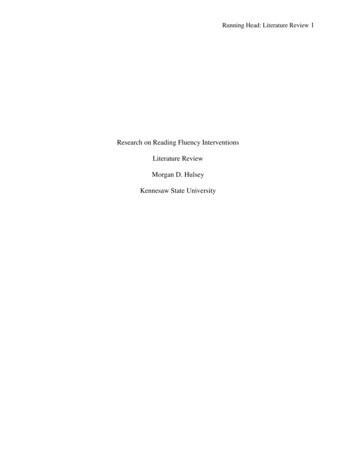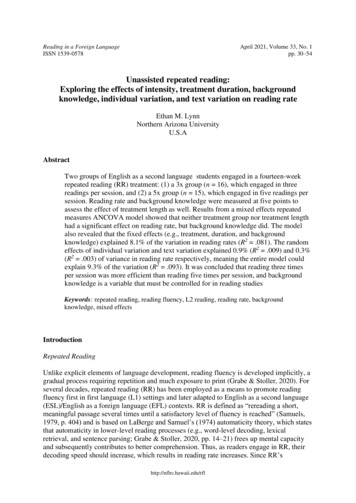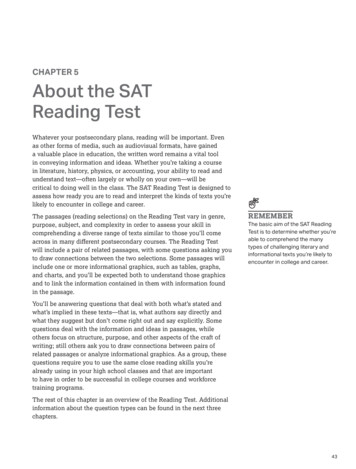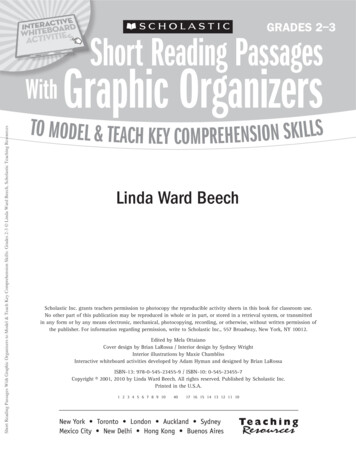
Transcription
Grades 2–3Short Reading Passages With Graphic Organizers to Model & Teach Key Comprehension Skills: Grades 2-3 Linda Ward Beech, Scholastic Teaching ResourcesWithShort Reading PassagesGraphic OrganizersLinda Ward BeechScholastic Inc. grants teachers permission to photocopy the reproducible activity sheets in this book for classroom use.No other part of this publication may be reproduced in whole or in part, or stored in a retrieval system, or transmittedin any form or by any means electronic, mechanical, photocopying, recording, or otherwise, without written permission ofthe publisher. For information regarding permission, write to Scholastic Inc., 557 Broadway, New York, NY 10012.Edited by Mela OttaianoCover design by Brian LaRossa / Interior design by Sydney WrightInterior illustrations by Maxie ChamblissInteractive whiteboard activities developed by Adam Hyman and designed by Brian LaRossaISBN-13: 978-0-545-23455-9 / ISBN-10: 0-545-23455-7Copyright 2001, 2010 by Linda Ward Beech. All rights reserved. Published by Scholastic Inc.Printed in the U.S.A.1 2 3 4 5 6 7 8 9 104017 16 15 14 13 12 11 10
Short Reading Passages With Graphic Organizers to Model & Teach Key Comprehension Skills: Grades 2-3 Linda Ward Beech, Scholastic Teaching ResourcesContentsIntroduction. . . . . . . . . . . . . . . . . . . . . . 3Foreign Flags. . . . . . . . . . . . . . . . . . . . 26Opposite Poles. . . . . . . . . . . . . . . . . . . 27Concept Webs: Topic/Main Idea and DetailsA State Apart. . . . . . . . . . . . . . . . . . . . 28Fancy Fireworks. . . . . . . . . . . . . . . . . . . 6Tales of Whales. . . . . . . . . . . . . . . . . . 29Things to Do in Maine. . . . . . . . . . . . . . 7Growing Up. . . . . . . . . . . . . . . . . . . . . 30Picture a Pigeon. . . . . . . . . . . . . . . . . . . 8Testing It Out. . . . . . . . . . . . . . . . . . . . 31The Inside Story. . . . . . . . . . . . . . . . . . . 9State Stuff. . . . . . . . . . . . . . . . . . . . . . 10A Fast Laugh. . . . . . . . . . . . . . . . . . . . 11What’s for Lunch?. . . . . . . . . . . . . . . . . 12So Many Symbols. . . . . . . . . . . . . . . . . 13Tracking Trains. . . . . . . . . . . . . . . . . . . 14Charts: ClassifyingBuilding Blocks. . . . . . . . . . . . . . . . . . 32Play Ball. . . . . . . . . . . . . . . . . . . . . . . 33Let’s Celebrate. . . . . . . . . . . . . . . . . . . 34Shaping Up. . . . . . . . . . . . . . . . . . . . . 35Testing It Out. . . . . . . . . . . . . . . . . . . . 15Bag Tags. . . . . . . . . . . . . . . . . . . . . . . 36Sequence Webs: SequenceQuilts of History. . . . . . . . . . . . . . . . . . 38Hello, Island!. . . . . . . . . . . . . . . . . . . . 16Turn on the Lights. . . . . . . . . . . . . . . . 17Here Come the Cranes. . . . . . . . . . . . . . 18A Painted Cave. . . . . . . . . . . . . . . . . . . 19Easy Opening. . . . . . . . . . . . . . . . . . . . 20Toys Through Time. . . . . . . . . . . . . . . . 21Balloons on Parade. . . . . . . . . . . . . . . . 22Testing It Out. . . . . . . . . . . . . . . . . . . . 23Venn Diagrams: ComparingOn the Ferry. . . . . . . . . . . . . . . . . . . . 24Looking at Leaves. . . . . . . . . . . . . . . . 25Blending In. . . . . . . . . . . . . . . . . . . . . 37Testing It Out. . . . . . . . . . . . . . . . . . . . 39Cause-and-Effect Maps: RelationshipsSilly Laws. . . . . . . . . . . . . . . . . . . . . . 40Cooling a Kampong. . . . . . . . . . . . . . . 41Eat and Read. . . . . . . . . . . . . . . . . . . . 42Fool the Birds. . . . . . . . . . . . . . . . . . . . 43Excellent Elephants. . . . . . . . . . . . . . . . 44Where the Sun Shines. . . . . . . . . . . . . . 45Seeing Red. . . . . . . . . . . . . . . . . . . . . . 46Testing It Out. . . . . . . . . . . . . . . . . . . . 47Answers. . . . . . . . . . . . . . . . . . . . . . . .48
Short Reading Passages With Graphic Organizers to Model & Teach Key Comprehension Skills: Grades 2-3 Linda Ward Beech, Scholastic Teaching ResourcesIntroductionIn your hands, you hold a surefire way to engage even the most reluctant learners and build thereading comprehension skills all students need to succeed. Using the 40 short, high-interest passages inthis book, each paired with a graphic organizer that supports its text structure, you’ll find an easy wayto help students learn how to find the main idea, understand cause and effect, compare and contrast,sequence events, and more. The ready-to-use Notebook files in the Companion Folder containactivities that make it easy to model these essential reading comprehension skills on your SMARTBoard. Following your lead, students can write, highlight, and underline key text right on the board.About the Graphic Organizers{.{Many students are visual learners and can benefitgreatly from using graphic organizers with their reading.Graphic organizers are especially helpful in identifyingand sorting information. Different types of graphicorganizers are particularly suited to certain types oftext structures:W Concept webs focus on main ideas and supportingdetails.W Sequence webs focus on sequential events or stepsin a process.W Venn diagrams focus on making comparisons.W Charts focus on classifying information.W Cause-and-effect maps focus on identifyingrelationships between events.As students complete a graphic organizer, they dothe following:WWWWWcreate a visual product based on their reading engage in understanding information from a passagesee relationships among words, facts, and ideas gain a sense of purpose and control over their readinglearn to paraphrase what they readPoint out that there is often more than one way to groupinformation from a passage. Encourage students to fill ingraphic organizers using their own words and phrases.(See the example on page 4.)3{Teacher Tips {W S uggest that students read the passageall the way through to get the generalidea. Then they can reread it to identifythe information needed in the organizer.W I f students are unfamiliar with a graphicorganizer, model its use before assigningthe page. Think aloud as you read thepassage, directions, and questions, andas you fill in the organizer.WB ecause of the limited amount ofspace on each page, you may want tomake enlarged copies of some graphicorganizers for students to use. Youmay also suggest that they draw largerversions of the graphic organizers onseparate sheets of paper.WU se the MORE! activities found atthe end of each reproducible graphicorganizer page to extend and expandstudents’ learning.
Short Reading Passages With Graphic Organizers to Model & Teach Key Comprehension Skills: Grades 2-3 Linda Ward Beech, Scholastic Teaching Resourcesmantlemantle ofhot rockcrustEarth’sPartsouter corecrust onoutsideEarth’sPartsouter corebetweeninner coreand mantleinner coreinner coreat centeriron andnickelHere are two different ways students might present information.The set of activities for each type of graphic organizer progresses from easier, offering students moresupport, to more challenging, allowing students greater independence. For instance the first conceptweb (page 6) includes the topic and one detail. The final concept web (page 14), however, requiresstudents to decide what the paragraph topic is and to identify all six examples that tell about the topic.The activities in between are scaffolded to provide an appropriate level of challenge for a range ofskill levels.No matter their skill level, by building graphic organizers, students are more likely to understand andretain information for reports, quizzes, tests, and discussions. Each section of the book concludes witha page called Testing It Out, which is set up as a typical bubble-style test. The test questions are alwaysbased on the passage on the preceding page. Students can easily see the relationship between creatinga graphic organizer and using that information on a test.4
Short Reading Passages With Graphic Organizers to Model & Teach Key Comprehension Skills: Grades 2-3 Linda Ward Beech, Scholastic Teaching ResourcesHow to Use the Companion Folder and Interactive Whiteboard {{.In the Companion Folder, you’ll find five Notebook files that correspond to each section of the bookand focus on a different type of graphic organizer.Simply choose the lesson with the skill that you wantto teach. Open the appropriate file on your interactivewhiteboard and scroll to the lesson. Each lesson iscomprised of 2 slides:W a text-only slide featuring the paragraphW a graphic organizer slideIt is a good idea to preview the lesson on your computer sothat you fully understand the lesson as well as the best wayto convey it to students on the interactive whiteboard.One strategy you may find helpful is to use the colored pensin the interactive whiteboard’s pen tray to help studentswho are visual learners. For example, circling, underlining,or highlighting the main idea of a passage in green and allof the supporting details in blue is a great way to organizeinformation by color. For consistency, use the same colorsto represent a concept when completing the graphicorganizers. This will also help students who are filling inthe graphic organizer quickly identify key information ifthey need to refer back to the paragraph slide.The final slide in each file contains an interactive versionof the Testing It Out page.Other Suggestions{.{W Be sure to use the activities that work best for theability levels in your classroom.W Encourage students to explain their thinking as theycomplete the organizers.W Have students work in cooperative groups tocomplete some activities. Assign roles such as reader(one who reads the passage to the group), highlighter(one who highlights relevant parts of the passage),mapper (one who fills in the graphic organizer), andchecker (one who reviews the completed graphicorganizer to be sure it is correct). Encourage groupmembers to switch roles.5{Teacher Tips {WW hile the interactive whiteboardlessons are perfect for whole-grouplearning, you can also use the Notebookactivities for mini-lessons, small-groupinstruction, differentiated instruction,and enrichment. The additional lessonscan be printed or photocopied forin-class practice, homework, andassessment.WA s you model how to use a graphicorganizer, pass out reproducibleversions of the activity you chooseto display, along with colored pencils,pens, or highlighters. Ask studentsto mark up their own copies as theyfollow along.W T o extend learning invite students tocontinue building onto the graphicorganizer with additional informationthey may already know.
Short Reading Passages With Graphic Organizers to Model & Teach Key Comprehension Skills: Grades 2-3 Linda Ward Beech, Scholastic Teaching ResourcesName DateFancy FireworksKaboom! It’s the Fourth of July. Fireworkslight up the night. Have you ever seen awillow firework? It has long trails of colorthat float to the ground. The pinwheel andcomet are two other popular fireworks. Oneof the loudest fireworks is called the salute.After a bright flash, you hear a loud BOOM!Read the paragraph. Then answer the questions.1. Which firework has long trails of color?2. Which firework makes a loud BOOM?3. What is a popular firework?Add three more details to the web.pinwheeldetailKinds ofFireworkstopicWhat do you think a pinwheel firework lookslike? Draw a picture to show your ideas.6
Short Reading Passages With Graphic Organizers to Model & Teach Key Comprehension Skills: Grades 2-3 Linda Ward Beech, Scholastic Teaching ResourcesName DateThings to Do in MaineMaine has 2,500 lakes and ponds for summerfun. There are more than 400 islands alongthe coast. People swim, fish, and sail offthese islands. Visitors enjoy eating in Maine,too. The state grows most of the blueberriesin the United States. In Maine, you can eatblueberry pie and lobster all summer long!Read the paragraph. Then answer the questions.1. What does Maine have along its coast?2. What fruit does Maine grow?3. What other food is Maine known for?Add three more details to the web.2,500 lakesand pondsdetailWhy PeopleGo to MainetopicFind Maine on a mapof the United States.7
Short Reading Passages With Graphic Organizers to Model & Teach Key Comprehension Skills: Grades 2-3 Linda Ward Beech, Scholastic Teaching ResourcesName DatePicture a PigeonWhat’s a city bird like? Many ofthe birds that live in cities arepigeons. These birds are usuallyfound on city sidewalks andon building rooftops. A pigeonweighs about half a pound. It canfly up to 60 miles an hour. Mostpigeons live for 10 to 15 years.Read the paragraph. Then answer the questions.1. How much does a pigeon weigh?2. How fast can a pigeon fly?3. How long does a pigeon live?Add three more details to the web.sidewalks androoftopsdetailPigeons inthe CitytopicBaby pigeons are called squabs.Add this fact to the web.8
Short Reading Passages With Graphic Organizers to Model & Teach Key Comprehension Skills: Grades 2-3 Linda Ward Beech, Scholastic Teaching ResourcesName DateThe Inside StoryYou live on the outside of Earth.This part of our planet is called thecrust. What is the inside of Earthlike? Just below the crust is themantle. It is made up of hot rock.Next comes the outer core. The innercore is the very center of Earth. Boththe outer and inner cores are made oftwo minerals—iron and nickel.outer corecrustmantleinner coreRead the topic in the web. Find fourdetails in the paragraph that tellabout the topic. Add them to the web.detailEarth’s PartstopicUse the web to tell someone aboutthe different parts of Earth.9
Short Reading Passages With Graphic Organizers to Model & Teach Key Comprehension Skills: Grades 2-3 Linda Ward Beech, Scholastic Teaching ResourcesName DateState StuffEach state in the United States has an officialflag and flower. Here are more fun factsabout some states. In Arizona, the statecolors are blue and gold. South Carolina’sstate amphibian is the salamander. Milkis the state drink in North Dakota. Mainehas a state insect—the honeybee. What’sthe Massachusetts state dessert? It’s Bostoncream pie, of course!Read the topic in the web. Find five detailsin the paragraph that tell about the topic.Add them to the web.Fun StateFactsFind out the following facts about your state: flower, nickname,bird, and one more fun fact. Make a web for your state.10
Short Reading Passages With Graphic Organizers to Model & Teach Key Comprehension Skills: Grades 2-3 Linda Ward Beech, Scholastic Teaching ResourcesName DateA Fast LaughWhen you laugh, air comes out of yourmouth at 16 miles per hour (mph). The airin a yawn can measure 9 mph. The air in asnore can be 6 to 7 mph. Air really moveswhen you hiccup. It can go 50 miles perhour! What’s the air speed of a sneeze?It’s 104 mph. Ah-choo! That’s faster thanthe wind in a hurricane!Read the topic in the web. Find five detailsin the paragraph that tell about the topic.Add them to the web.Body AirSpeedsMake a bar graph. Use theinformation in the paragraph.11
Short Reading Passages With Graphic Organizers to Model & Teach Key Comprehension Skills: Grades 2-3 Linda Ward Beech, Scholastic Teaching ResourcesName DateWhat’s for Lunch?Have you ever had a string bean sandwich?Most students wouldn’t want that for lunch!What is the favorite sandwich in America’sschool lunches? If you said peanut butterand jelly, you’d be right. Other popularsandwiches are ham and bologna. Cheese isthe fourth favorite sandwich. Many studentsalso like turkey sandwiches.What is the topic of the paragraph?Write it in the center circle. Find fivedetails that tell about the topic.Write them in the web.What kinds of sandwiches does your classlike the best? Take a survey of your class.12
Short Reading Passages With Graphic Organizers to Model & Teach Key Comprehension Skills: Grades 2-3 Linda Ward Beech, Scholastic Teaching ResourcesName DateSo Many SymbolsA symbol is a picture or object thatstands for something else. For example,the American flag stands for the UnitedStates. Uncle Sam is another U.S. symbol.The name comes from the initials U.S.Have you seen the Statue of Liberty? Thestatue is a symbol for our country andgovernment. The Liberty Bell stands forour freedom. Another symbol, the baldeagle, also stands for freedom.What is the topic of the paragraph? Write it in the center circle.Find five details that tell about the topic. Write them in the web.Another U.S. symbol is the Great Seal. Add this factto the web. Find out what the Great Seal stands for.13
Short Reading Passages With Graphic Organizers to Model & Teach Key Comprehension Skills: Grades 2-3 Linda Ward Beech, Scholastic Teaching ResourcesName DateTracking TrainsTrains carry just about everything. Differentkinds of train cars carry different things.The locomotive pulls the train. It carries theengineer, or driver. A hopper car carries thingslike coal, sand, and salt. A flatcar carries largethings like telephone poles. The poles must betied down. Gas is carried in a tanker car. Aboxcar can hold many things, from animalsto toys. The caboose is at the end of the train.It holds offices and beds for the crew.What is the topic of the paragraph? Write it in the center circle.Find six details that tell about the topic. Write them in the web.The paragraph describes a freight train. Find out what theword freight means. Write a sentence using the word.14
Short Reading Passages With Graphic Organizers to Model & Teach Key Comprehension Skills: Grades 2-3 Linda Ward Beech, Scholastic Teaching ResourcesName DateTesting It OutUse after completing Tracking Trains on page 14.Fill in the circle of the best answer.1. The main idea of the paragraph is that—A boxcars hold many different kinds of thingsB different train cars carry different thingsC the locomotive is the most important carD a train has six different kinds of cars2. A train car that carries sand is a—A locomotiveB hopperD caboose3. The last car in a freight train is the—A locomotiveB cabooseC hopperD tankerC boxcar4. You can guess that a flatcar can carry—A big pipesB gasC sandD pigs5. A tanker might carry—A animalsB logsC the crewD oil6. The most powerful car on a freight train must be the—A tankerC flatcarB locomotiveD caboose7. On long trips, the engineer probably sleeps in the—A boxcarC cabooseB locomotiveD tanker8. Piles of wheat would be carried in a—A hopperB locomotiveC flatcarD boxcar15
Short Reading Passages With Graphic Organizers to Model & Teach Key Comprehension Skills: Grades 2-3 Linda Ward Beech, Scholastic Teaching ResourcesName DateHello, Island!About 30 years ago, some fishermenwere on their boat near Iceland.Suddenly they saw smoke comingfrom the sea. Then the top of avolcano rose out of the water. Soonred-hot rock began to pour downits sides. It looked like the sea wason fire. At last the volcano cooleddown. It became a new island. Peoplenamed the island Surtsey.Read how the island of Surtsey was made. Show the correct order ofwhat happened. Write the numbers from 1–4 on the lines.Red-hot rock poured down its sides.Smoke came out of the sea.The new island was named Surtsey.The volcano cooled down.Fill in the circles in order. Use the numbers and sentences above to helpyou. The first one is done for you.123Smoke cameout of the sea.Tell someone how Surtsey became an island.Draw pictures to show what happened.164
Short Reading Passages With Graphic Organizers to Model & Teach Key Comprehension Skills: Grades 2-3 Linda Ward Beech, Scholastic Teaching ResourcesName DateTurn on the LightsLighthouses warn ships that are near land.The first lighthouses were fires. People wouldbuild the fires on hilltops along the coast.Later, people built towers. The light from theircandles could be seen from far away. Thenoil lamps were used. Today electricity runs alighthouse’s powerful lamps.lamptowerRead how lighthouses changed.Show the correct order of what happened.Write the numbers from 1–4 on the lines.Oil lamps lit lighthouses.Lighthouses use electric light.Fires were built on hillsides.Candles were used.Fill in the circles in order. Use the numbersand sentences above to help you.123Read The Little Red Lighthouse and theGreat Gray Bridge by Hildegarde Swift.174
Short Reading Passages With Graphic Organizers to Model & Teach Key Comprehension Skills: Grades 2-3 Linda Ward Beech, Scholastic Teaching ResourcesName DateHere Come the CranesAbout half a million sandhill cranes cover thesky. Every March, these large birds come tothe Platte River in Nebraska. The river is animportant stop on the birds’ trip north. Forabout six weeks, the cranes rest and eat there.Then, as the spring breezes turn warm, thebirds leave. They head for the far north. Thecranes’ mating season begins there.Read about the sandhill cranes’ trip.Show the correct order of what happens.Write the numbers from 1–4 on the lines.The cranes fly to the far north.The mating season begins.The cranes eat and rest.The cranes come to the Platte River.Fill in the circles in order. Use the numbersand sentences above to help you.123The sandhill cranes fly to the Platte River fromthe Gulf of Mexico. Add this fact to the web.184
Short Reading Passages With Graphic Organizers to Model & Teach Key Comprehension Skills: Grades 2-3 Linda Ward Beech, Scholastic Teaching ResourcesName DateA Painted CaveA very long time ago, people lived in caves.Here’s how four boys found some very oldcave paintings in France. They were outwith their dog Robot. Suddenly the boyscouldn’t find Robot. Then they heard the dogbarking—under the ground! The boys climbeddown a hole to find Robot. They also found acave with paintings on its walls and ceiling.Someone had painted them over 15,000 yearsago! Today these cave paintings are famous.Read about how the cave paintings were found. Show the correct order ofwhat happened. Write the numbers from 1–5 on the lines.Robot gets lost.The boys hear barking and climb into a hole.The boys find cave paintings.Four boys go out with their dog.The cave paintings become very famous.Fill in the circles in order. Use the numbers and sentences above to help you.Suppose you could ask each of the four boysa question. What would you ask them?19
Short Reading Passages With Graphic Organizers to Model & Teach Key Comprehension Skills: Grades 2-3 Linda Ward Beech, Scholastic Teaching ResourcesName DateEasy OpeningIn 1959, the Fraze family wason a picnic. They had forgottento bring a can opener. Mr. Frazefinally opened the can on thebumper of his car. “There must bea better way,” he said. One night,Mr. Fraze invented the pop-topcan. About 20 years later, heinvented the push-in, fold-backtop. It’s still in use today.Complete the sequence web.Show the correct order ofwhat happened. The first oneis done for you.no can openerat picnicErmal Fraze was from Dayton, Ohio.Find this city on a United States map.20
Short Reading Passages With Graphic Organizers to Model & Teach Key Comprehension Skills: Grades 2-3 Linda Ward Beech, Scholastic Teaching ResourcesName DateToys Through TimeSome toys have been around fora long time. Others are muchnewer. One of the earliest toysis the whistle. Many NativeAmerican children had whistles.The rocking horse is about 200years old. Crayons have beenaround for about 100 years.Video games are fairly new.The first one came out about 40years ago, in 1970. The first bikewas made 150 years ago.Complete the sequence web.Show the order in which toyswere first used.The Frisbee is about 70 years old.Where would that go on the web?21
Short Reading Passages With Graphic Organizers to Model & Teach Key Comprehension Skills: Grades 2-3 Linda Ward Beech, Scholastic Teaching ResourcesName DateBalloons on ParadeMany people enjoy the bigballoons at the ThanksgivingDay parade in New York City.Here’s how these balloons aremade. First drawings of whatthe balloon might look like aredone. Next, small models arecreated. Then workers cut outand put together the piecesfor the big balloon. Finallythe balloon is blown up andpainted.Complete the sequence web.Show the order in whichparade balloons are made.Draw your ownparade balloon.22
Short Reading Passages With Graphic Organizers to Model & Teach Key Comprehension Skills: Grades 2-3 Linda Ward Beech, Scholastic Teaching ResourcesName DateTesting It OutUse after completing Balloons on Parade on page 22.Fill in the circle of the best answer.1. The first step in making a parade balloon is—A making modelsC doing drawingsB blowing it upD painting it2. After the balloon is blown up, it is—A cheered by crowdsB poppedD painted3. The models of the balloon are—A largeB smallC 5 feet tallD 500 feet tall4. The balloon pieces are cut out—A before the drawings are doneB before the balloon is blown up5. The models are important because they—A are made before the drawings are doneB appear in the paradeC put in a paradeC after they are paintedD after the parade beginsC are put inside the balloonD show what the balloon will look like6. The paragraph suggests that making a parade balloon—C is done by one personA is easyD is a sad jobB takes time7. The paragraph does not tell you—A where the Thanksgiving Day Parade isB when the balloon is painted8. You can guess that the balloons are—A easy to carryB used all yearC where the balloons are kept during the yearD which parade the balloon is forC very smallD made carefully23
Short Reading Passages With Graphic Organizers to Model & Teach Key Comprehension Skills: Grades 2-3 Linda Ward Beech, Scholastic Teaching ResourcesName DateOn the FerryYou’re in a car. You come to a biglake. There’s no bridge. How doyou get across? In some places,you can take a boat called a ferry.A car ferry has ramps so you candrive onto the boat. Some ferriesare for trains. These boats havetracks on them. Both kinds offerries are about 330 feet long.Read the paragraph. Then answer the questions.1. What is the job of each kind of ferry?2. How long are most ferryboats?3. Which kind of ferry has tracks?4. Which kind of ferry has ramps?Write your answers in the correct parts of the circles.Car FerryBothTrain FerryPlanes can land on some ships. Findout what these ships are called.24
Short Reading Passages With Graphic Organizers to Model & Teach Key Comprehension Skills: Grades 2-3 Linda Ward Beech, Scholastic Teaching ResourcesName DateLooking at LeavesYou can recognize a tree by the shapeof its leaves. The leaves on a beechtree have a long, narrow shape. Theyalso have uneven edges. The leaves onblack gum trees are about the sameshape as beech leaves. But black gumleaves have smooth edges. In the fall,black gum leaves turn yellow. Beechleaves turn orange-brown.Black GumBeechRead the paragraph. Then answer the questions.1. What are the edges of each kind of leaf like?2. What color does each kind of leaf turn?3. What shape are the leaves on both trees?Write your answers in the correct parts of the circles.BeechBothBlack GumFind leaves from two different trees. Make a diagramlike the one on this page. Fill in the diagram to showhow the leaves are alike and different.25
Short Reading Passages With Graphic Organizers to Model & Teach Key Comprehension Skills: Grades 2-3 Linda Ward Beech, Scholastic Teaching ResourcesName DateForeign FlagsEvery country has its own flag. Japan hasa white flag with a red circle on it. The redcircle stands for the sun. Japan’s name meansthe “land of the rising sun.” Canada also hasa red and white flag. But its flag has a whitebackground with two wide red stripes. In thecenter of the flag is a red maple leaf. Themaple tree is a symbol of Canada.Read the paragraph. Then answer the questions.1. What colors are both flags?2. What does Japan’s flag have in the center?3. What does Canada’s flag have in the center?4. How are the backgrounds of the two flags different?Write your answers in the correct parts of the circles.JapanBothCanadaFind Japan and Canadaon a world map.26
Short Reading Passages With Graphic Organizers to Model & Teach Key Comprehension Skills: Grades 2-3 Linda Ward Beech, Scholastic Teaching ResourcesName DateOpposite PolesThe South Pole is on the continentof Antarctica. Where is the NorthPole? It’s in the middle of the ArcticOcean. There is no land at the NorthPole—just slabs of ice. Both polesare very cold places. Both have sixmonths of daylight and six monthsof darkness. People don’t make theirhomes on either pole, but scientistsdo work on Antarctica. They studythe ice and rocks there.North PoleSouth PoleRead the paragraph. Write facts ineach part of the Venn diagram.South PoleBothNorth PoleWhen it is dark at the North Pole, it is lightat the South Pole. Find out why this is so.27
Short Reading Passages With Graphic Organizers to Model & Tea
reading comprehension skills all students need to succeed. Using the 40 short, high-interest passages in this book, each paired with a graphic organizer that supports its text structure, you’ll find an easy way to help students learn how to find the main idea, understand cause and
